Businesses today are concerned with two vital questions.
“Who do you design your product for?”
Once you find an answer for that, you start wondering,
“What do my users want?”
Products are mainly created to solve user’s problems, besides business profit. Building a solution without understanding the users is senseless.
So to make products successful, knowledge about the users is crucial. If you are wondering how to gain user understanding and apply them to development, here’s your answer:
Creating user personas.
Dive in to know how to build user personas for your SaaS product.
What is a user persona?
User personas are semi-fictional characters that represent your actual target customers. They are created based on the data you get by researching the users.
A user persona covers your user’s goals, behavioral patterns, attitude, skills, etc. It gives your team a realistic depiction of your users.
Also, your target user might be vast. Their behaviors and goals differ. Different categories of users might find your product as a solution for their problem. When your user base is broad, you need to cater to every group.
Personas, by nature, are used to depict different user segments. It ensures that you don’t miss out on any category.
Why are user personas important for your SaaS product?
Empathizing with users
The success of your product depends on how much it resonates with your customers. To create user-centric products, you have to understand and empathize with users.
User personas are the key to this.
From ideating the product features to designing them, you must stay aligned with the user’s mindset. User personas give you a clear picture of users, their likes and dislikes. It helps your team stay relevant to your users.
Awareness of user’s problems is significant as you develop a product. Personas convey user pain points effectively to designers and developers. It enables the team to come up with the right solution.
Decision making
The product team needs to think through the appropriate features that solve users’ problems.
Every team consists of different people. These people are unique thanks to their varied perceptions and ideas. It’s natural for them to have a difference of opinions. When there are two or more design approaches, the team needs to decide.
These decision-making points occur very often in the product design process. What’s important is that every design decision must prioritize the users. In these times of confusion and chaos, user personas can act as a guide helping the teams decide on what’s best for the user.
Communicating information
In building SaaS products, your team must be aware of the purpose and vision. It makes them stay aligned. In communicating these things, a big part is about the users. If they don’t get a clear picture of who your users are, it is hard to bind them together.
Raw and plain data are often less interesting to the team members.
Moreover, it takes a lot of time to process the data. Concluding what they convey and coming up with actionable insights take a lot of time. And data about users is hard to interpret.
A user persona is the processed data that is given to the team in a very presentable manner.
With user persona, product owners can effectively convey the user information. User personas are structured in a way similar to storytelling. It makes it easier to gauge and process the details.
How to create user personas?
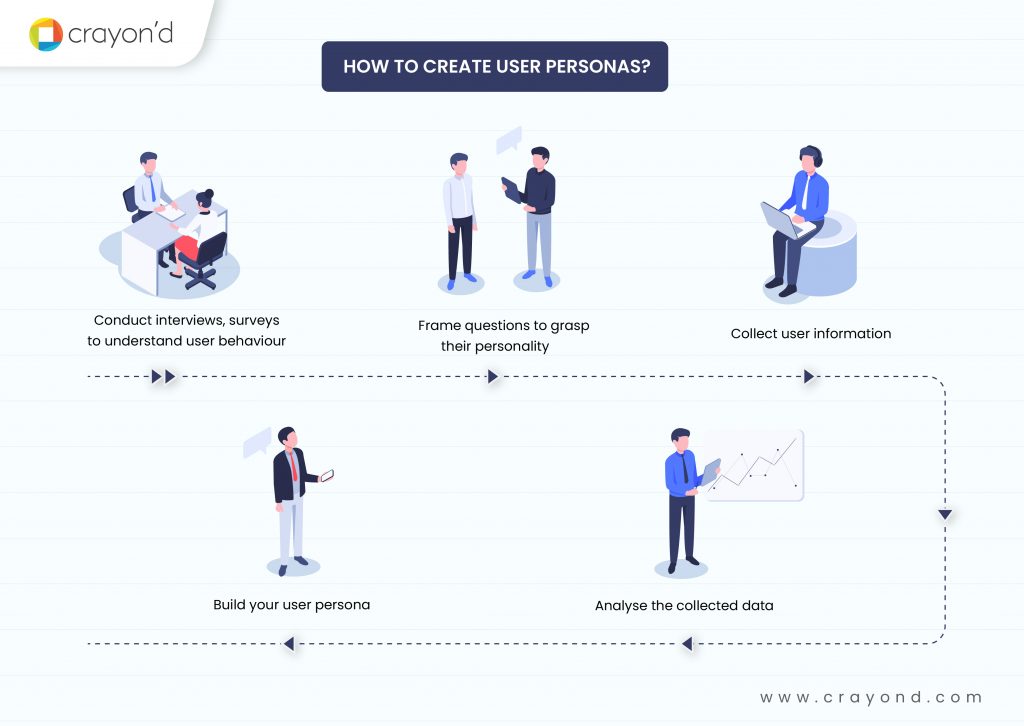
Step 1-Gather user information
Knowledge about users is the basement on which user personas are built. You begin by collecting information about your users.
Wait! There’s something you need to do before that.
Know who your target users are.
There’s no harm in checking if you are targeting the right set of users. If there isn’t a problem here, you are all set to begin your user research process.
You can do user research through interviews, surveys, and web analytics. Web analytics gives an understanding of existing user behavior. Among these methods, user interviews are very effective.
User interviews uncover more insights about the target users. You can observe and learn more about them. Make sure you ask them the right questions.
You can ask them about their goals and problems. Frame questions that will let you understand their behavior and personality.
For example, you can ask questions like these
- What are your professional and non-professional goals?
- Describe your typical day.
- How do you spend your spare time?
- What are your favorite brands?
- What brings you frustration?
- What are the hindrances you face in achieving your goals?
The questions should provide enough information for creating personas.
Step 2-Analyze data
It’s time for data analysis. In user research, your questions are open-ended. It means the users provide a variety of information. Segregate them and extract only the data necessary for persona creation.
One of the purposes of persona is to classify your target audience. You can group similar people into one persona. Research your data and identify repeated characteristics. Look out for behavioral patterns.
See main trends in the data. If a majority of people have said something similar, pick it out as a trait. Apply this for all the information like goals, pain points, etc.
Step 3-Build your user persona
Now, you can start creating personas. Frame the personas in a way they are easier to understand. Make sure that this helps your team to perceive the right image of the user.
Personas must have a personal touch to look realistic. However, too many details bring in confusion. And also, your team might not get the right message.
A SaaS product rarely targets only one kind of user. You can create more than one persona. But don’t go overboard. 3-5 would be an optimum number.
Now, coming to the content of the personas, here’s what a persona consists of:
- Name
- Demographic information
- Age
- Gender
- Job
- Family information
- Location
- Income
- Goals and needs
- Pain points
- Other behavioral information
Remember that user personas are general information about different user types. They represent a group of target audiences and not just a single user. Hence the name, age, job, and location are derived from multiple user data.
Here’s a simple persona template. You can find varieties of user persona templates out there. Make use of them or create one yourself to document your personas.
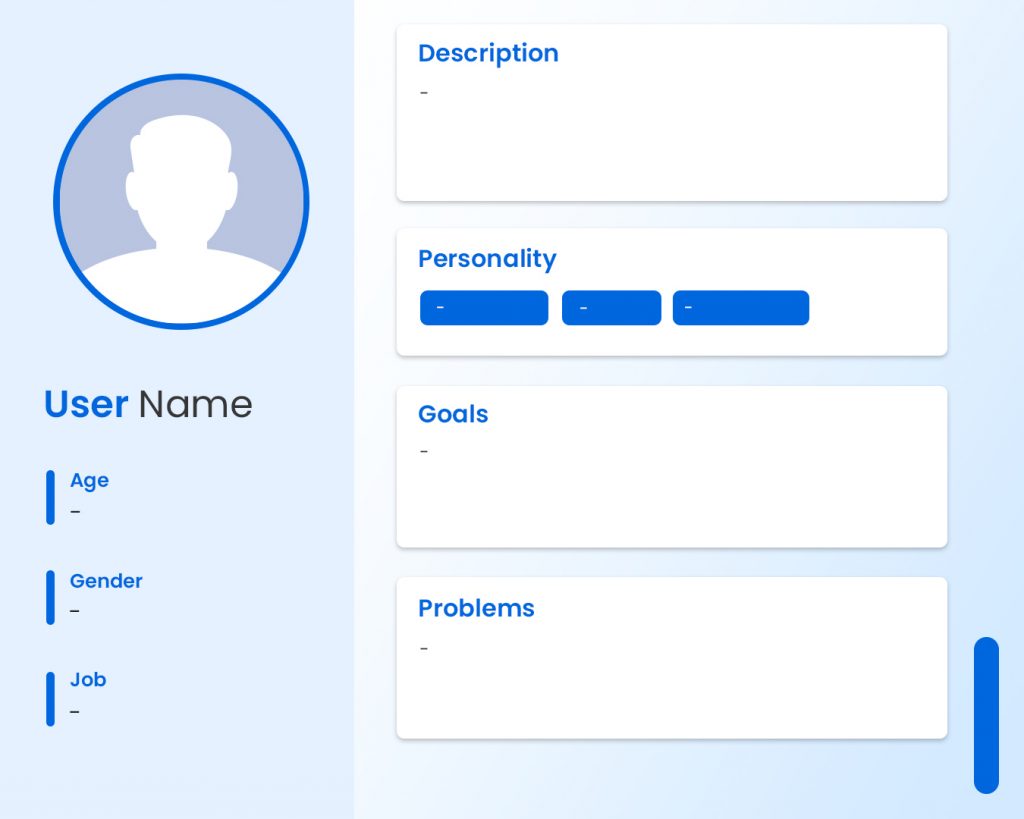
User persona examples
Consider the Swiggy App.
Who do you think their major users are?
These are 3 common types. But there can be more personas as well.
- Bachelors
- Working individuals
- Partying people
Let’s use these target user groups to paint the user persona examples.
Bachelor persona
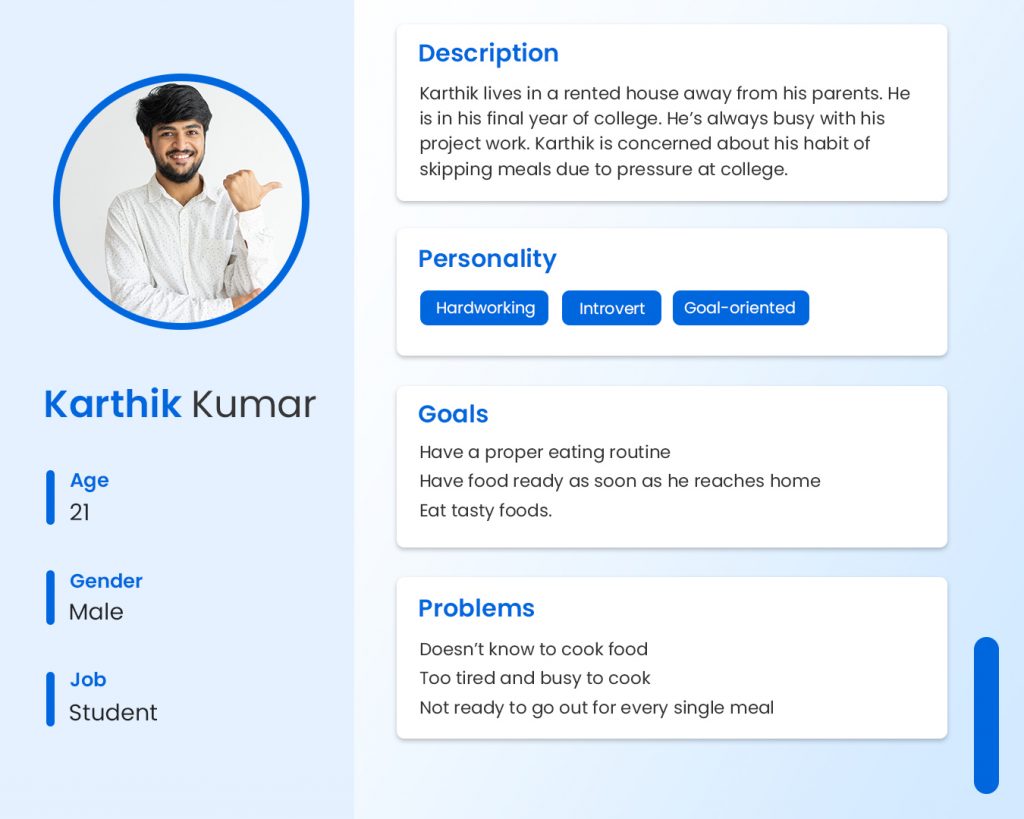
Working individual persona
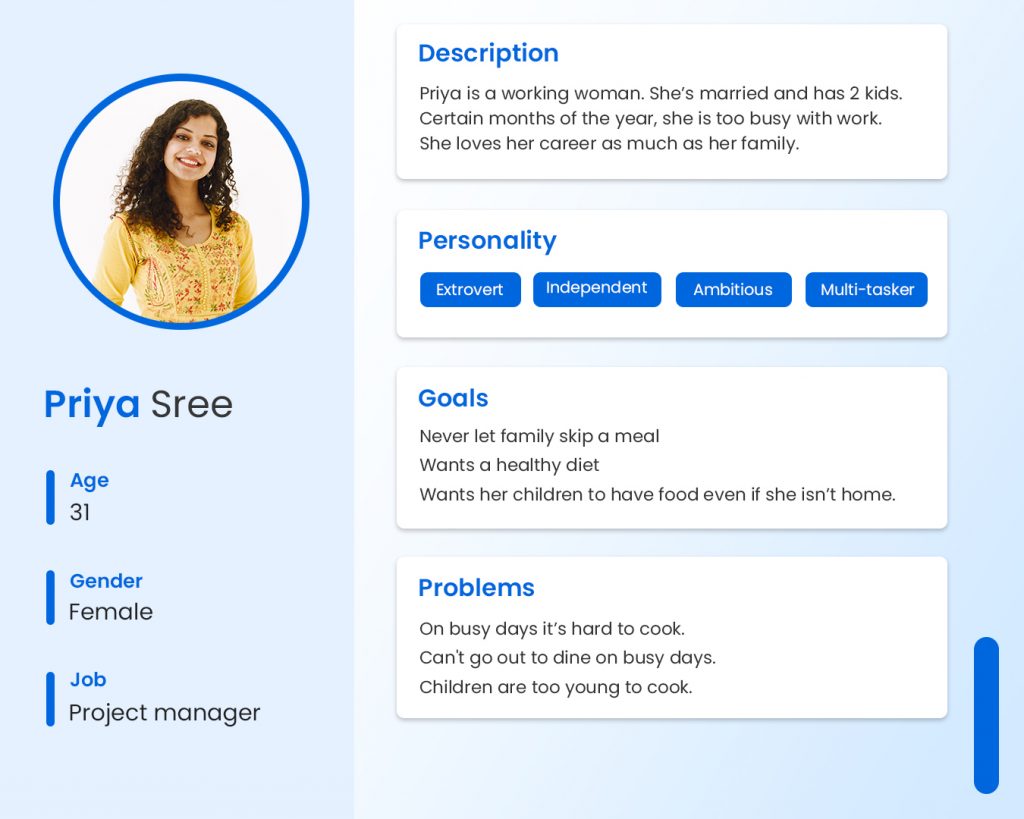
Party lover persona
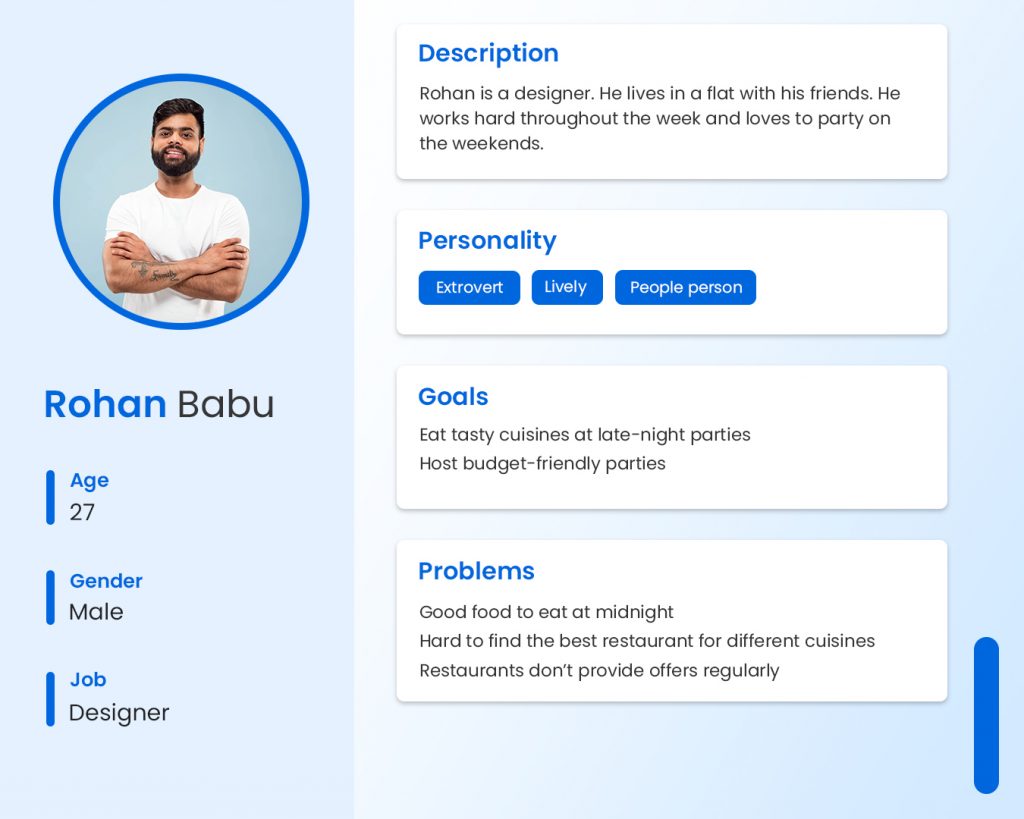
Where are personas used?
As you start ideating your product features, user personas come into the picture. They help the product team to be aware of different user categories. It ensures that the product doesn’t alienate any of its user groups. Businesses can cater to all of their users with the aid of user personas.
In the design process, they help in deciding the relevant UI and UX elements for the product. User personas help designers get inside the mind of the users. As a result, every design element is designed from the user’s perspective.
Your team needs user personas throughout the product development process. They help you stay relevant with the users. It’s a key for creating user-centric SaaS products.
How user personas benefits business?
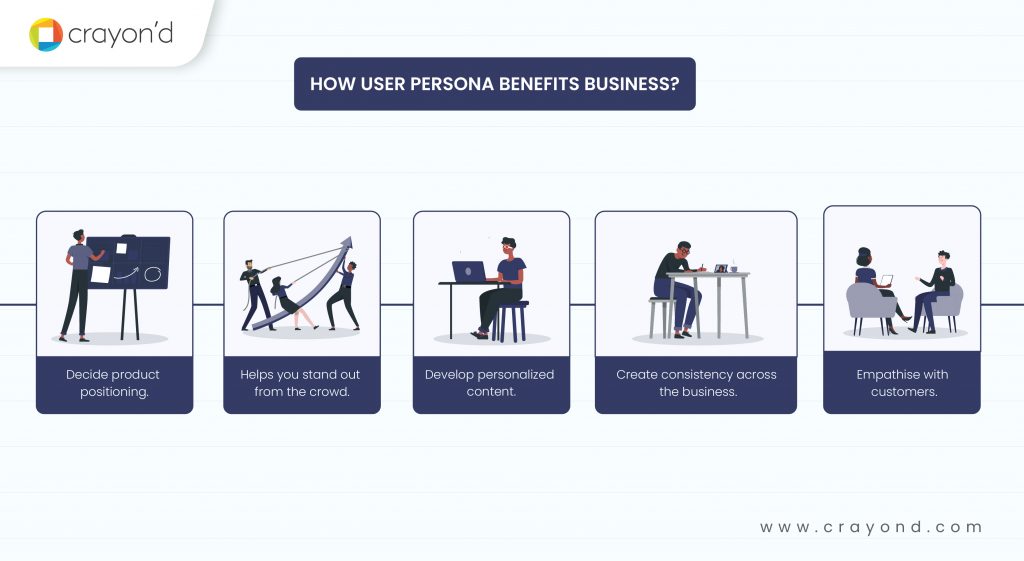
Tips for creating user personas
- Get rid of assumptions
- Assumptions are dangerous when it comes to user personas. Just think of the vast areas personas are used. When you build your personas based on assumptions, all these processes get the impact. As a result, your SaaS product might not meet the user’s needs.
- It is a great hindrance to creating user-centric products. You must be very cautious and must be able to distinguish facts. Be open-minded to accept the data truths over your assumptions. Make your personas purely out of factual and original data.
- Ensure it’s concise
- The human mind abstains from reading long textual data. Modern times are such that the attention span has reduced. Also, there is a trend of consuming small format content. Both are interrelated.
- Ensure your persona is concise. Sometimes your team needs to refer to it and gain an idea of the users swiftly. It should be able to give insights with a quick reference. In that case, make your personas with necessary highlights with bites of information.
- Make it look captivating.
- Raw data is boring because it is just plain. Visual elements add zest to any data. That’s why infographics are hugely popular.
- You should present personas in a way that is enticing to the eyes. Add visual effects to the persona document. You can also add illustrations or images. It makes the persona document more appealing and approachable. And, the visual representation makes it more memorable as well for the team.
- User-focused and not buyer-focused
- Remember that your user personas are different from the buyer personas. Not often, the buyers are actual users of your product. So when you are doing the research, don’t get carried away by buyer profiles.
- Buyers might also cover influencers and reviewers. They might not use the product in the long term.
- Buyer goals vary from the actual user goals. Also, the user personas are used in the development process. But you do use buyer personas in the marketing phases.
- So make sure to look for users instead of buyers when creating the user persona.
- Use only relevant information
- Adding unwanted details to the persona is the biggest blunder you can commit. It takes away the team’s focus from the actual vital data.
- Add details that are only relevant to your SaaS product. Some personal data might not even give any insights or be of use here. Avoid them in your persona.
Characteristics of a Good User Persona
Your persona is one of the few bases over which the product is built. It must be nothing less than good. See if your personas possess the following characteristics that make them good and right.
- Speak for the data
User persona should be the extract of the data you have collected. They should reflect the information from your research. In other words, personas should stay true to your data insights. Any deviation is an issue here.
- Realistic, not ideal
User persona should be the representation of the real users- their needs and pain points. This should not under any circumstances get affected by your perception. Never make the persona reflect your ‘ideal user’ image. It should represent your real user base.
- The present condition of users
Your persona should talk about the present needs, goals, and problems of your users. It should not be focused on their future needs. People focus is on their present problems. The future comes only next to it. People will not prefer products that get them closer to a future goal to a product that solves their current problems.
- Don’t restrict the classifications to demographics
Though demographics play an important role, your user persona shouldn’t be a mere demographic classification. They should be focused on their behaviors and needs. Demographics don’t always mean they can be put together in a group to be called personas. It’s their behavioral patterns and problems, that should be given concentration.
- Updated regularly
The rate at which the products are created and used brings our focus to the rapid changes in needs. Users and the market keeps evolving. Wouldn’t it be a blunder to use the older personas? Keep updating your personas at regular intervals.
Endnote
We are in the end-user era now. More than ever, it’s crucial now to create user-centric products.
The product-led growth trend is now prominent among users. And so, user experience has become a significant influencer in product adoption and success.
To craft products that are highly relevant to the users, user personas are greatly helpful.
If you aren’t using them, that’s probably the biggest mistake you are committing. If you still haven’t started working on your personas, do not worry.
Now is the right time to begin.
Build personas and put your product on the path to success.


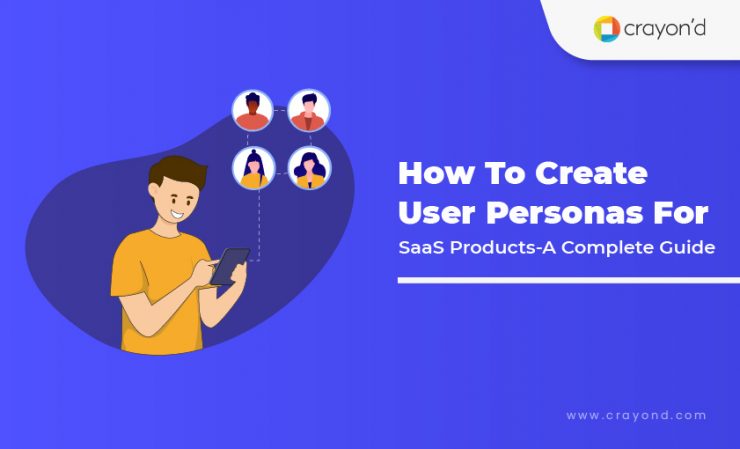




Add comment